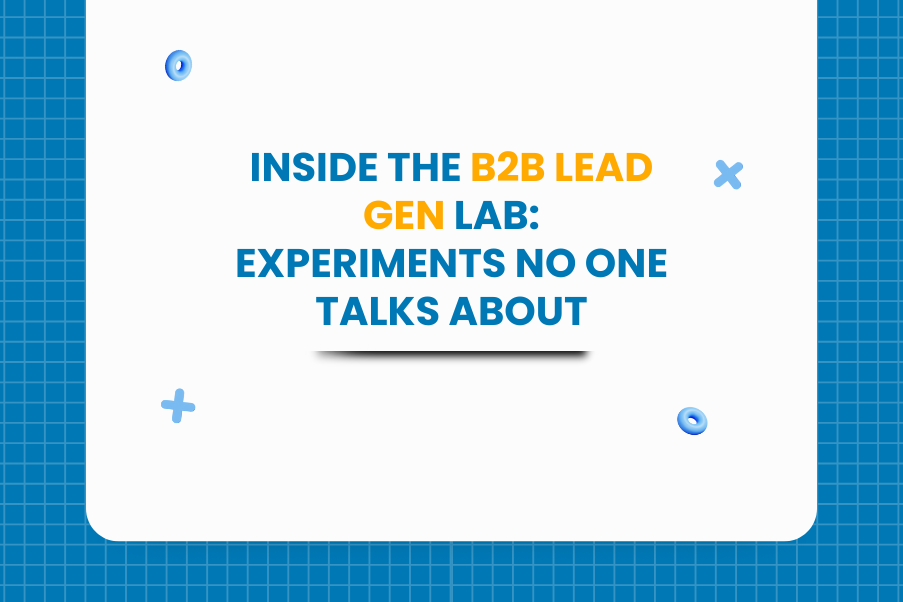Are You Maximising B2B Content Syndication Services in 2025? Here’s What’s Changed

B2B content syndication services have emerged as a cornerstone strategy for marketers seeking to boost visibility, generate high quality leads, and accelerate buyer journeys.
With 89% of B2B marketers using syndication for lead generation, it is clear that content syndication isn’t just a trend. It is a proven tactic that continues to evolve. But to succeed today, it is not enough to simply distribute content. Marketers must adopt a targeted, strategic, and data driven approach that keeps pace with changing buyer behaviors, privacy regulations, and technological advancements.
This blog explores everything you need to know about maximizing B2B content syndication services in 2025, from understanding how B2B content syndication works to new trends, proven strategies, performance metrics, and how to align efforts across marketing and sales for lasting impact.
What is B2B Content Syndication
B2B content syndication services refer to a marketing strategy where businesses republish their existing content such as whitepapers, case studies, eBooks, blogs, or videos on third-party websites, industry publications, or media networks. The goal is to increase the content’s visibility, reach new audiences, and generate high quality B2B content syndication leads.
Instead of waiting for potential buyers to find your content organically, B2B content syndication platforms help you proactively put your content in front of a highly targeted audience that matches your Ideal Customer Profile (ICP) in terms of job title, industry, location, and intent.
How Does B2B Content Syndication Work?
Choose a Syndication Platform or Partner:
You begin by selecting a B2B content syndication service provider or a marketing agency that specializes in syndication. These partners have access to large, segmented databases and high traffic publishing networks relevant to your industry.
Provide Gated Content:
You share high value, downloadable content like whitepapers, reports, or webinars. These assets are usually gated, meaning users must fill out a form with their details to access the content.
Set Targeting Parameters:
You define the specific audience you want to reach. This includes criteria such as job function (e.g., CFOs), industry (e.g., manufacturing), company size, location, and sometimes buying stage.
Content Distribution:
The B2B content syndication platform promotes your content to their network via email, content hubs, media websites, or programmatic ad platforms, ensuring it reaches the right people at the right time.
Lead Collection and Delivery:
When a user expresses interest and submits their information, their details are captured and validated. These contacts are then passed back to you as B2B content syndication leads for nurturing and follow-up.
What’s Changed in 2025?
The fundamentals of B2B content syndication services remain the same but the approach in 2025 is more refined, intelligent, and aligned with buyer expectations. Here’s how the landscape has evolved:
1. From Quantity to Quality
In the past, success in B2B content syndication was often measured by the number of leads generated. However, in 2025, marketers are shifting their focus from volume to value. The priority now lies in understanding lead intent, evaluating engagement quality, and identifying how likely a lead is to convert into a customer. It’s not just about collecting contacts, it’s about nurturing meaningful interactions that align with business goals.
2. AI-Driven Targeting
B2B content syndication platforms in 2025 are leveraging artificial intelligence and machine learning to optimize targeting strategies. These platforms analyze data based on user behavior, job function, industry, content preferences, and purchase intent. This allows marketers to deliver content to a more precise audience, improving both lead quality and conversion rates.
3. Privacy Compliance is Non-Negotiable
With stringent data privacy regulations such as GDPR, CCPA, and India’s DPDP Act, businesses can no longer afford to overlook compliance. B2B content syndication services in 2025 are built around transparency, consent, and ethical data practices. Providers must rely on first-party data and leads must be collected through clear opt-in processes.
4. Integrated Nurturing Journeys
Once a lead is captured, the engagement doesn’t end there. In 2025, organizations have sophisticated marketing automation in place to nurture these leads effectively. Prospects are automatically enrolled into personalized email sequences, added to retargeting campaigns, or segmented into appropriate funnels. This multi-touch nurturing approach helps move B2B content syndication leads swiftly through the buyer journey.
Key B2B Content Syndication Strategies for 2025
To truly maximize the impact of your B2B content syndication services in 2025, it’s essential to go beyond basic distribution and adopt a more strategic, targeted, and performance-driven approach. Here are the most effective B2B content syndication strategies to elevate your efforts:
1. Set Clear Goals from the Start:
Before launching any campaign, define your goals clearly. Are you aiming to increase brand awareness, generate MQLs, or nurture pipeline accounts? Your goals will influence content format, B2B content syndication platform choice, and success metrics.
2. Pick the Right Channels:
Choose B2B content syndication platforms that align with your industry and audience. If you’re running an ABM strategy, ensure your platform can deliver your content to the right decision-makers in the right accounts.
3. Optimize Your Content for Syndication:
Your content must be tailored for the syndication environment.
Include:
- Valuable insights or data
- Scannable layouts
- Visuals like infographics or charts
- A compelling CTA
Remember, in 2025, video and interactive content outperform static formats, which is critical for effective B2B content syndication strategies.
4. Focus on Audience Relevance:
Match your content to the buyer journey. Use top-of-funnel formats like blogs or B2B content syndication examples for awareness, and deeper assets like demos and case studies for decision-stage buyers.
5. Align with Sales for Follow-Up:
Make sure your sales team understands the campaign, content, and intent behind each lead. Provide them with contextual insights so they can engage B2B content syndication leads faster and more effectively.
Measuring Syndication Success: What to Track
To ensure your B2B content syndication services are delivering real business value, it’s essential to track the right performance metrics. Simply generating leads isn’t enough. You need to understand the quality, intent, and outcome of those leads. Here are the key indicators that will help you evaluate ROI and continuously improve your syndication strategy:
1. Lead Volume and Quality
Start by looking at the number of leads generated, but don’t stop there. Assess the quality of those leads by checking if they match your Ideal Customer Profile (ICP), considering factors like job title, company size, industry, and location. A large number of unqualified leads wastes time and resources, whereas a smaller list of high intent and high fit leads can yield far better results.
2. Click Through Rate (CTR)
CTR measures the percentage of people who clicked on your content out of those who saw it. A high CTR indicates that your content, title, or call to action was compelling enough to drive interest. Low CTRs may signal a mismatch between your content and the audience or suggest that your headline needs improvement. Monitoring CTR helps you optimize messaging and asset formats over time.
3. Engagement Metrics
Beyond clicks, analyze how users interact with your syndicated content. Key engagement metrics include time spent on page, scroll depth, number of shares, and downloads. High engagement shows that your content is relevant and valuable, while low engagement could indicate that your content isn’t resonating with the audience or lacks clarity and depth.
4. Conversion Rate to MQL and SQL
Track how many leads from your syndication efforts convert into Marketing Qualified Leads (MQLs) and eventually into Sales Qualified Leads (SQLs). This is a strong indicator of content effectiveness and targeting accuracy. If conversion rates are low, it might mean that leads are either not a good fit or not nurtured properly after initial contact.
5. Revenue Attribution
The ultimate goal of content syndication is to generate revenue. Use attribution models such as first touch, multi touch, or last touch to see how syndicated leads contribute to closed deals. Look at the percentage of revenue influenced by these leads to understand the true business impact of your syndication campaigns.
6. Cost per Lead (CPL) and Overall ROI
Finally, calculate your Cost per Lead by dividing the total campaign spend by the number of qualified leads generated. Then assess the Return on Investment (ROI) by comparing the cost of the campaign to the total revenue or pipeline generated from it. A healthy ROI confirms that your strategy is working, while a high CPL with low conversion may signal the need to adjust targeting, content, or partner platforms.
Conclusion
The B2B content syndication services landscape in 2025 demands more than just distribution. It calls for precision, personalization, and performance tracking. With AI enhanced platforms, stricter privacy norms, and smarter buyers, syndication is no longer a volume game. It is about generating qualified B2B content syndication leads, nurturing them through integrated journeys, and aligning with sales to convert interest into revenue.
By setting clear goals, choosing the right B2B content syndication platforms, optimizing your content for relevance and engagement, and measuring key metrics like lead quality, CPL, and ROI, you can turn syndication into a powerful engine for growth.
In a noisy digital world, the brands that syndicate smartly, not just widely, will lead the conversation and win the trust of today’s B2B buyers.
Looking to supercharge your lead generation in 2025? Partner with Almoh Media, a trusted B2B content syndication service provider that helps you reach the right audience, generate high-intent leads, and deliver measurable results.
FAQ
1. Why are B2B content syndication services important for lead generation in 2025?
B2B content syndication services play a crucial role in modern lead generation by distributing your content across trusted third-party platforms. This approach increases visibility, targets decision-makers based on your Ideal Customer Profile (ICP), and delivers high-intent B2B content syndication leads. In 2025, with smarter platforms and tighter privacy norms, it’s a scalable and compliant way to generate quality leads.
2. How does B2B content syndication work in 2025?
B2B content syndication works by republishing gated assets—like whitepapers or webinars on relevant third-party sites or B2B content syndication platforms. You define targeting parameters (e.g., job title, industry, location), and the platform promotes your content to matched audiences. When prospects engage and submit their details, you receive qualified leads for follow-up and nurturing.
3. What are the top B2B content syndication strategies for better ROI?
To improve ROI from B2B content syndication services, use strategies like setting clear campaign goals, choosing niche platforms, aligning content with the buyer journey, leveraging interactive formats, and syncing closely with your sales team. In 2025, integrating AI tools and multi-touch nurturing journeys is also key to converting B2B content syndication leads into revenue.
4. Which B2B content syndication platforms should businesses consider?
The best B2B content syndication platforms in 2025 are those that offer precise audience segmentation, strong compliance practices, and integration with your CRM or marketing automation tools. Leading options include platforms with intent data capabilities, programmatic reach, and proven success with your target industry or account-based marketing (ABM) goals.
5. Can you share some B2B content syndication examples that work?
Effective B2B content syndication examples include promoting an industry report on a finance portal targeting CFOs, or syndicating a manufacturing case study on a sector-specific media site. Webinars, whitepapers, and solution briefs are commonly used assets. The key is matching the content format and message to the audience’s buying stage and channel preference.
Final Thought
Success in B2B content syndication isn’t about blasting your content across more channels — it’s about placing it where your audience is actually looking, researching, and deciding. In 2025, relevance, precision, and timing have taken center stage. That means smarter targeting, intent data, and a strategy that aligns with how buyers actually behave today.
At Almoh Media, we help brands move from guesswork to growth — with content syndication programs that are built to convert, not just circulate.
Curious if your syndication strategy is keeping up? Let’s find out together.
-
 Why the ‘Slow Lead’ Proves the Real Benefits of Outsourcing Lead Gen
Why the ‘Slow Lead’ Proves the Real Benefits of Outsourcing Lead Gen -
 The Rise of the Micro-Buyer: How SaaS Lead Generation Companies Are Powering Faster B2B Decision
The Rise of the Micro-Buyer: How SaaS Lead Generation Companies Are Powering Faster B2B Decision -
 Inside the B2B Lead Gen Lab: Experiments No One Talks About
Inside the B2B Lead Gen Lab: Experiments No One Talks About -
 5 Criteria That Separate Great B2B Content Syndication Service Providers from the Pretenders
5 Criteria That Separate Great B2B Content Syndication Service Providers from the Pretenders -
 Outsourced Telemarketing Services: When the Phone Call Still Wins in the Digital Era
Outsourced Telemarketing Services: When the Phone Call Still Wins in the Digital Era
-
 Why the ‘Slow Lead’ Proves the Real Benefits of Outsourcing Lead Gen
Why the ‘Slow Lead’ Proves the Real Benefits of Outsourcing Lead Gen -
 The Rise of the Micro-Buyer: How SaaS Lead Generation Companies Are Powering Faster B2B Decision
The Rise of the Micro-Buyer: How SaaS Lead Generation Companies Are Powering Faster B2B Decision -
 Inside the B2B Lead Gen Lab: Experiments No One Talks About
Inside the B2B Lead Gen Lab: Experiments No One Talks About -
 5 Criteria That Separate Great B2B Content Syndication Service Providers from the Pretenders
5 Criteria That Separate Great B2B Content Syndication Service Providers from the Pretenders -
 Outsourced Telemarketing Services: When the Phone Call Still Wins in the Digital Era
Outsourced Telemarketing Services: When the Phone Call Still Wins in the Digital Era

